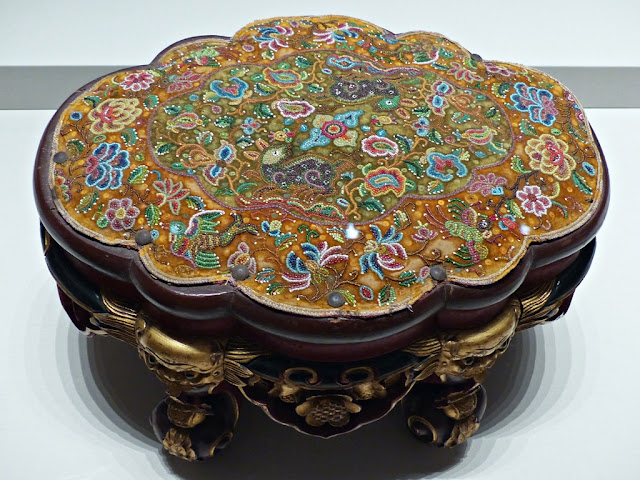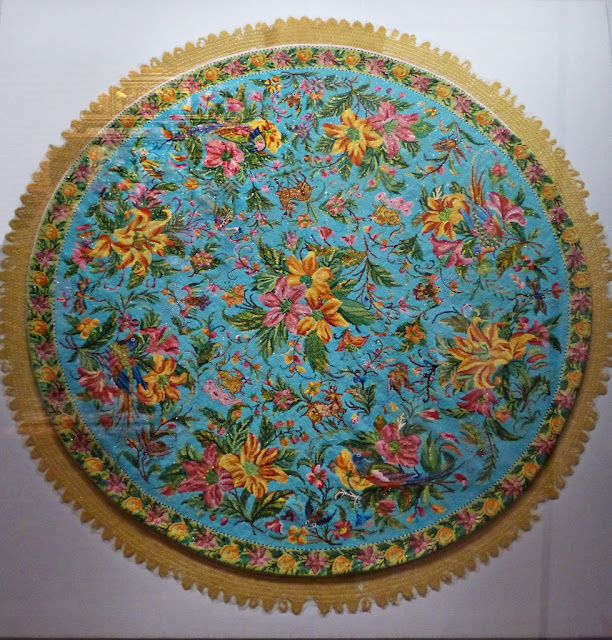During my last stay in Singapore a month ago I visited the Peranakan Museum and was really impressed with the amazing examples of Peranakan beadwork. One work was especially memorable: a large (126 x 118 cm) tablecloth made from over a million glass beads, featuring in its design colourful flowers, birds and insects on a turquoise ground. This is the largest known example of Peranakan beadwork in the world. One must visit the museum if only to see this master piece.
 Close up of a beaded tablecloth, Penang, early 20th century, The Peranakan Museum, Singapore
Close up of a beaded tablecloth, Penang, early 20th century, The Peranakan Museum, Singapore
First of all, who are the Peranakans? The term Peranakan generally refers to people of mixed Chinese and Malay/Indonesian heritage. Many Peranakans trace their origins to 15th century Malacca where their ancestors were thought to be Chinese traders who married local women. The Peranakans were also known as Straits Chinese as they were usually born in the British-controlled Straits Settlements of Singapore, Penang and Malacca. They combined the elements of the Chinese, Malay and sometimes European culture into their own.
 Different parts of the beaded tablecloth, Penang, early 20th century, The Peranakan Museum Singapore
Different parts of the beaded tablecloth, Penang, early 20th century, The Peranakan Museum Singapore
Beadwork was used by Peranakans women (referred as nyonyas) extensively, almost entirely for decorating objects for weddings: hangings for the marriage bed, panels to hang over mirrors and panels for the pillows, tableclothes, bridal ceremonial handkerchiefs, knee pads, collars for groom, shoes, belts and purses. Beadwork was also commonly made into casual slippers, spectacles cases, small vases etc. Colourful beads and more intricate patterns were embroidered for joyous occasions such as Chinese New Year; black, white or blue colours with simple repeated patterns were embroidered for funeral ceremonies.
 Another fragment of the beaded tablecloth, Penang, early 20th century, The Peranakan Museum, Singapore
Another fragment of the beaded tablecloth, Penang, early 20th century, The Peranakan Museum, Singapore
 Brown and gold footstool decorated with beadwork, Malacca, early 20th century. The Peranakan Museum, Singapore
Brown and gold footstool decorated with beadwork, Malacca, early 20th century. The Peranakan Museum, Singapore
There was no special craft school to learn beadwork craft and the skills were handed down by grandmothers, mothers or aunts from generation to generation. As early as the 18th to 19th centuries, Rocaille beads were commonly used in the Peranakan beadwork. Rocaille beads came from France, Venice or Germany and were cut in flattened spherical shapes, irregular at the sides. When beaded together, Rocaille beads have a finer texture, due to their diminutive size and lustrous glittering glow. It is interesting that the shell beads so popular in other areas of South East Asia were never used. Nowadays popular beads "Charlottes" from Czech Republic and "Miyuki" beads from Japan are commonly used in the Peranakan beadwork.
 Round beadwork tablecloth, Penang, Straits Settlements, early 20th century, The Peranakan Museum, Singapore
Round beadwork tablecloth, Penang, Straits Settlements, early 20th century, The Peranakan Museum, Singapore
Colours of the Peranakan beadwork are high in contrast and vibrant and the design motifs usually demonstrate a fusion of various influences - Chinese, European and local cultures. During the 18th to 19th centuries most of the motifs sewn were inspired by traditional and auspicious Chinese symbols and beliefs such as peonies representing feminine, beauty, love and affection; bat, deer and crane symbolizing happiness, wealth and longevity; qilin, a mythical animal and a very auspicious symbol believed to be a bringer of sons; insects like dragonfly, grasshopper and cicada symbolizing fertility. Flowers were often clustered together in bunches of nine: the Chinese character for the number nine sounds like the character for "long" (as a measure of time) and so it was used to represent "everlasting happiness". Birds were also beaded in pairs to represent an auspicious reunion and as a symbol of double blessings. The many seeds of the pomegranate, peach and finger citron were used as symbols of progeny, longevity and wealth respectively. When embroidered together, it symbolized the three abundances. Other compositions of the beadwork included a bee hovering above a peony symbolizing the bee as the young man and the peony as the girl he marries.
 Beaded slippers, Straits Settlements, 1930s. The Peranakan Museum, Singapore
Beaded slippers, Straits Settlements, 1930s. The Peranakan Museum, Singapore
 Silver spittoon with beaded bottom panel, Indonesia, early 20th century
Silver spittoon with beaded bottom panel, Indonesia, early 20th century
Motifs of marine life, such as crab, squid, prawn, goldfish and carp often appeared as primary motifs or as border decorations in early beadwork, fish representing abundance, prawn representing happiness and crab representing prosperity.
 Beadwork panel, Penang, early 20th century, The Peranakan Museum, Singapore
Beadwork panel, Penang, early 20th century, The Peranakan Museum, Singapore
With time western influences gradually crept into designs. The peony and European rose combination commonly appeared in various beadworks during the second half of the 19th century and became increasingly popular from the early 20th century on. At the same time Chinese themes and mythical symbols of the phoenix and qilin were significantly reduced and another motifs emerged instead such as European cartoon characters, Western couples holding hands or phrases in English such as "forget me not" and "good luck" though these new motifs were mostly used for decorating slippers and purses.
 Oval beadwork tablecloth, Penang, Straits Settlements, early 20th century. The Peranakan Museum, Singapore
Oval beadwork tablecloth, Penang, Straits Settlements, early 20th century. The Peranakan Museum, Singapore
Beadwork can be considered an authentic Peranakan craftsmanship. It is also one of the few cultural elements that have become appreciated in modern times. More and more young Peranakan women take classes in traditional beadwork and there is a hope that this amazing art will be revived.
 Fragment of a beaded tablecloth, Penang, early 20th century, The Peranakan Museum Singapore
Fragment of a beaded tablecloth, Penang, early 20th century, The Peranakan Museum Singapore  Close up of a beaded tablecloth, Penang, early 20th century, The Peranakan Museum, Singapore
Close up of a beaded tablecloth, Penang, early 20th century, The Peranakan Museum, Singapore Different parts of the beaded tablecloth, Penang, early 20th century, The Peranakan Museum Singapore
Different parts of the beaded tablecloth, Penang, early 20th century, The Peranakan Museum Singapore Another fragment of the beaded tablecloth, Penang, early 20th century, The Peranakan Museum, Singapore
Another fragment of the beaded tablecloth, Penang, early 20th century, The Peranakan Museum, Singapore Brown and gold footstool decorated with beadwork, Malacca, early 20th century. The Peranakan Museum, Singapore
Brown and gold footstool decorated with beadwork, Malacca, early 20th century. The Peranakan Museum, Singapore  Round beadwork tablecloth, Penang, Straits Settlements, early 20th century, The Peranakan Museum, Singapore
Round beadwork tablecloth, Penang, Straits Settlements, early 20th century, The Peranakan Museum, Singapore Beaded slippers, Straits Settlements, 1930s. The Peranakan Museum, Singapore
Beaded slippers, Straits Settlements, 1930s. The Peranakan Museum, Singapore Silver spittoon with beaded bottom panel, Indonesia, early 20th century
Silver spittoon with beaded bottom panel, Indonesia, early 20th century Beadwork panel, Penang, early 20th century, The Peranakan Museum, Singapore
Beadwork panel, Penang, early 20th century, The Peranakan Museum, Singapore Oval beadwork tablecloth, Penang, Straits Settlements, early 20th century. The Peranakan Museum, Singapore
Oval beadwork tablecloth, Penang, Straits Settlements, early 20th century. The Peranakan Museum, Singapore



I recently purchased a rug from DeRugDealer, and it completely transformed my living room! The quality and design are exceptional. Highly recommend for anyone looking to add warmth and style to their home.
ReplyDeleterugs for home